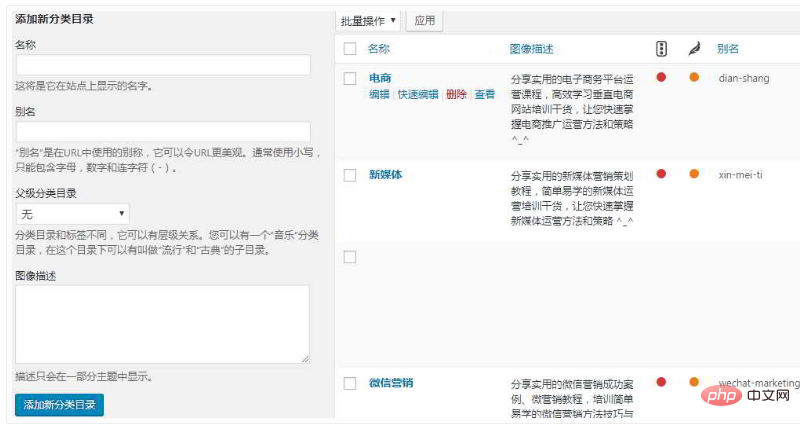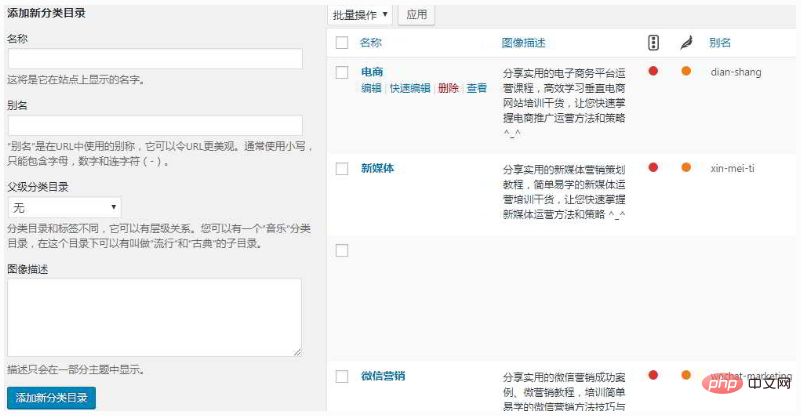How to create a category directory in wordpress

How to create a category directory in wordpress
Before creating categories, it is best to clearly understand the direction of the website content , then list the preferred category names (usually use 2-6 words).
WordPress Category Directory
Log in to WordPress backend → Article → Category Directory
You can see the category creation and category management interface

How to add a new category?
By default, there are 4 options for adding categories:
名称 别名 父级分类目录 描述
1) Name
The name of the category, usually 2-6 words
As shown in the following picture of "WeChat Marketing" in the WordPress category directory

2) Alias
is mainly used for URLs in the category directory .
https://www.chenweiliang.com/china-phone-number is the alias of the category directory "China Mobile Number".
(WordPress will automatically add /category to the URL by default in to distinguish it from the article category directory)
3) Parent category directory
The default is the first-level category, and sub-categories can also be created under the first-level category;
If you can also classify the content of the first-level category into more detailed parts, please consider adding a sub-category.
3) Description
Describe the content of this category, and some WordPress themes, Description will be called as the description of the category.
How to set the default category?
The main purpose of the default category is that if it is not specified manually when writing the article The category of the article will be automatically divided into the default category.
Log in to the WordPress backend → Settings → Write
to set the "default article category directory".
How to manage existing categories?
By placing the mouse on the category name, the management menu of the category directory will appear
Edit | Quick Edit | Delete | View
As shown below in the WordPress category "E-commerce"

You can click to view it.
Please be sure to note that if a certain If a category is the "default category" and cannot be deleted, you can set other categories as the default category first, and then delete the category.
How to check the category ID?
Sometimes, for example, some WordPress theme setting options need to fill in the category ID to call the content of the category. At this time, you need to view the category ID
, put the mouse on the category name, and then right-click "Copy link address" ” to get the following link:
https: //域名/edit-tags.php?action=edit&taxonomy=category&tag_ID=1&post_type=post
where ID=1 is the ID of this category directory
For more WordPress technical articles, please visit the WordPress Tutorial column!
The above is the detailed content of How to create a category directory in wordpress. For more information, please follow other related articles on the PHP Chinese website!

Hot AI Tools

Undresser.AI Undress
AI-powered app for creating realistic nude photos

AI Clothes Remover
Online AI tool for removing clothes from photos.

Undress AI Tool
Undress images for free

Clothoff.io
AI clothes remover

Video Face Swap
Swap faces in any video effortlessly with our completely free AI face swap tool!

Hot Article

Hot Tools

Notepad++7.3.1
Easy-to-use and free code editor

SublimeText3 Chinese version
Chinese version, very easy to use

Zend Studio 13.0.1
Powerful PHP integrated development environment

Dreamweaver CS6
Visual web development tools

SublimeText3 Mac version
God-level code editing software (SublimeText3)

Hot Topics
 1386
1386
 52
52
 PHP vs. Flutter: The best choice for mobile development
May 06, 2024 pm 10:45 PM
PHP vs. Flutter: The best choice for mobile development
May 06, 2024 pm 10:45 PM
PHP and Flutter are popular technologies for mobile development. Flutter excels in cross-platform capabilities, performance and user interface, and is suitable for applications that require high performance, cross-platform and customized UI. PHP is suitable for server-side applications with lower performance and not cross-platform.
 How to change page width in wordpress
Apr 16, 2024 am 01:03 AM
How to change page width in wordpress
Apr 16, 2024 am 01:03 AM
You can easily modify your WordPress page width by editing your style.css file: Edit your style.css file and add .site-content { max-width: [your preferred width]; }. Edit [your preferred width] to set the page width. Save changes and clear cache (optional).
 In which folder are wordpress articles located?
Apr 16, 2024 am 10:29 AM
In which folder are wordpress articles located?
Apr 16, 2024 am 10:29 AM
WordPress posts are stored in the /wp-content/uploads folder. This folder uses subfolders to categorize different types of uploads, including articles organized by year, month, and article ID. Article files are stored in plain text format (.txt), and the filename usually includes its ID and title.
 How to create a product page in wordpress
Apr 16, 2024 am 12:39 AM
How to create a product page in wordpress
Apr 16, 2024 am 12:39 AM
Create a product page in WordPress: 1. Create the product (name, description, pictures); 2. Customize the page template (add title, description, pictures, buttons); 3. Enter product information (stock, size, weight); 4 . Create variations (different colors, sizes); 5. Set visibility (public or hidden); 6. Enable/disable comments; 7. Preview and publish the page.
 Where is the wordpress template file?
Apr 16, 2024 am 11:00 AM
Where is the wordpress template file?
Apr 16, 2024 am 11:00 AM
WordPress template files are located in the /wp-content/themes/[theme name]/ directory. They are used to determine the appearance and functionality of the website, including header (header.php), footer (footer.php), main template (index.php), single article (single.php), page (page.php), Archive (archive.php), category (category.php), tag (tag.php), search (search.php) and 404 error page (404.php). By editing and modifying these files, you can customize the appearance of your WordPress website
 How to search for authors in WordPress
Apr 16, 2024 am 01:18 AM
How to search for authors in WordPress
Apr 16, 2024 am 01:18 AM
Search for authors in WordPress: 1. Once logged in to your admin panel, navigate to Posts or Pages, enter the author name using the search bar, and select Author in Filters. 2. Other tips: Use wildcards to broaden your search, use operators to combine criteria, or enter author IDs to search for articles.
 Which version of wordpress is stable?
Apr 16, 2024 am 10:54 AM
Which version of wordpress is stable?
Apr 16, 2024 am 10:54 AM
The most stable WordPress version is the latest version because it contains the latest security patches, performance enhancements, and introduces new features and improvements. In order to update to the latest version, log into your WordPress dashboard, go to the Updates page and click Update Now.
 Does wordpress need to be registered?
Apr 16, 2024 pm 12:07 PM
Does wordpress need to be registered?
Apr 16, 2024 pm 12:07 PM
WordPress requires registration. According to my country's "Internet Security Management Measures", websites that provide Internet information services within the country must register with the local provincial Internet Information Office, including WordPress. The registration process includes steps such as selecting a service provider, preparing information, submitting an application, reviewing and publishing, and obtaining a registration number. The benefits of filing include legal compliance, improving credibility, meeting access requirements, ensuring normal access, etc. The filing information must be true and valid, and must be updated regularly after filing.




